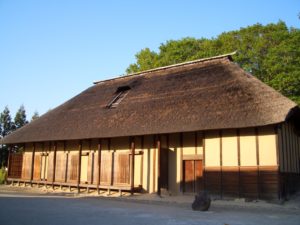It gives the opportunity to think about family
This is beautiful. The house of the Konno is in Tagajyo city in Miyagi prefecture and is next to Tohoku History Museum. The building is registered as a tangible cultural asset of the prefecture. Its huge thatched roof catches visitors’ eyes. Its main house, built in 1769, is Spartan. It has six rooms and a large kitchen. The family was kimoiri, the village headman, in the Edo era. His house shows his power quietly. There are two rooms to have officials down the corridor. Since then time has changed, but it is still easy for ordinary people to realise that the family was affluent. With a good structure, houses like this deserve to be called yashiki or castle if you like.
Old houses are preserved across the country, but what is remarkable about this house is that it offers the opportunity to learn the traditional family system. There are two toilets. One is for the master; and the other for the rest of the family. The kitchen, too, is divided into two. One is for the family use; and the other for servants. It is surprising to see these clear differences in social status and positions under the same roof. This makes visitors think about how patriarchy was like. Besides, unlike today where families sit around the table to eat together, people at that time used low tables to eat meals individually. This makes a difference in how children think of their fathers between the past and today. Fathers were very scary in the past.
With little information on him, it is unclear whether the master was scary or not. But he does not seem to be unkind. That is evidenced by the fact that there were two families who had lost their houses in the Konno’s house where his wife, mother and grand-father and sister lived. This suggests he had a strong sense of justice.
Regardless the number of family members, people learn from their families. I guess that people around the kirimori learnt important things, such as how to live and die, from his behaviour and works. Although he was a politician who has to play a dirty trick, he did good things, which is why this house is still worthwhile. Household and Buddhist altars inside the house suggest this. Worshipping his ancestors, he prayed for his family’s prosperity, health, the success of his job and peace in the village. He had care and compassion not just for his family but people in the village. He protected all of them.
The Japanese word ie (family) contains a meaning of “spread a blanket on things”. This can be interpreted as “defend”. Meantime, the English word family is derived from “serve”, which originally came from “slave”. This can mean “working for others”. These things are linked: home is the place where people do them at home. “A house is a fine house when good folks are within”, a British proverb says. They are common but important and are steadily disappearing today. Isolation of individuals and solitary death of elderly people are increasing. But Japan’s triple disasters made family values stronger than ever. What will it be like in the future? Who knows, but because somehow people feel fragile, this house may be valuable enough to be a cultural asset. If so, it’s a pity.

Ryo Kubota is a staff writer at Transpheric Management in Tokyo as well as a freelance writer. He has covered Sports for the Nippon Newspaper Company in Tokyo and teaches at a private tutoring school in Iruma, Japan. Having studied in both Tokyo and England in the areas of sociology, he has a keen interest in the world at large.









